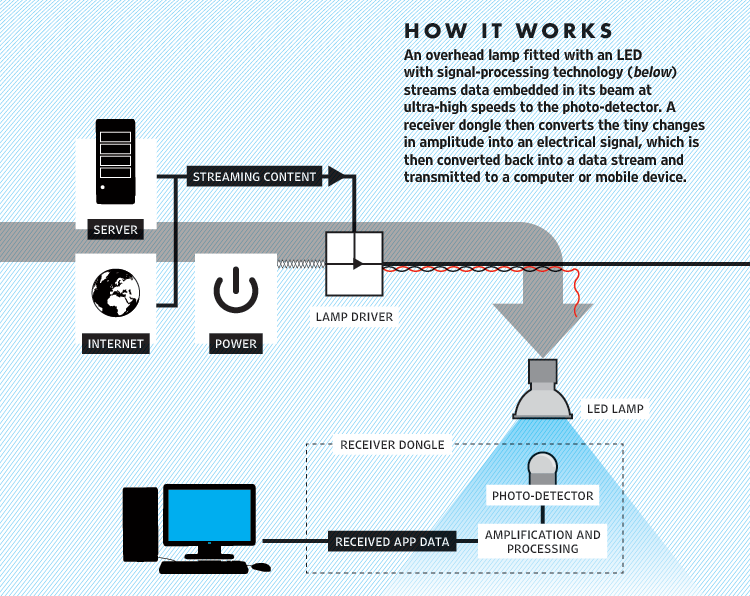Li-Fi enables data transmission through illumination by taking the fiber out of fiber optics by sending data through a LED light bulb. Li-Fi is visible electromagnetic spectrum and has higher bandwidth than Wi-fi but has Line of sight limitation. Li-Fi promises to be cheaper and more energy-efficient than the existing wireless radio systems given the ubiquity of LED bulbs and the fact that lighting infrastructure is already in place.
Li-Fi was coined by Professor Harald Haas from the University of Edinburgh in the UK and pure VLC’s CSO, and refers to a type of VLC technology that delivers a networked, mobile, high-speed communication solution in a similar manner as Wi-Fi. Developed exclusively in France by Oledcomm the startup of the System Engineering Laboratory of the University of Versailles, it was presented for the first time in the “connected home” of France Television at the LeWeb 12 forum, as the revolution of tomorrow! Visible light is part of the electromagnetic spectrum and 10,000 times bigger than the radio spectrum, affording potentially unlimited capacity.
Advantages of Li-Fi:
A frequencies band completely free and unlicensed worldwide
Every Li-Fi light unit can convey up to 10 times more information than a Wi-Fi Hot-Spot
Adapted to buildings or infrastructures where GSM and Wi-Fi are forbidden or cannot pass
No interference with radio waves and electromagnetic fields
Geolocation information :
You can target information to relay accurately depending on the lighting device
Exchange your files safely :
As light does not cross walls, you have an increased security of your wireless
Combined to LED lighting you can save energy up to 80% compared to a traditional lighting
Omnipresence of LEDs in domestic lighting, industrial, displays and urban signage
Ability of multi-user communication
And the drawbacks are that if you block the light and the signal will be blocked.
Somehow, Li-Fi also a potential advantage from a security point of view. Light cannot penetrate walls as radio signals can, so drive-by hacking of wireless internet signals would be far more difficult, if not impossible. Even though the technology is still infancy, it needs further developments in microchip design and optical communication controls before it could go mass market.

No comments:
Post a Comment